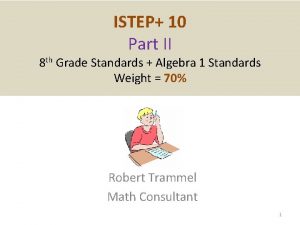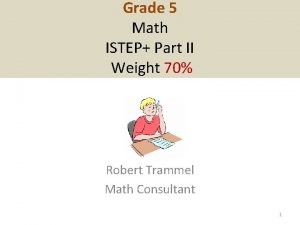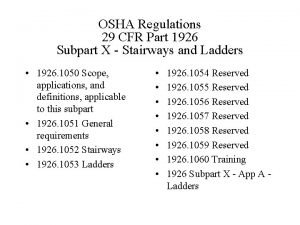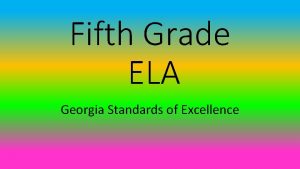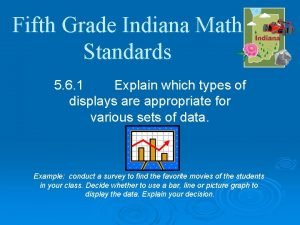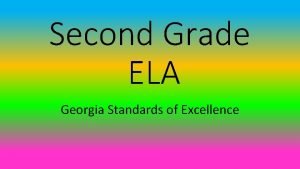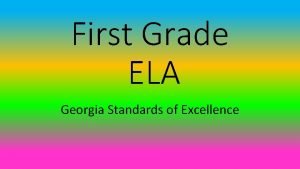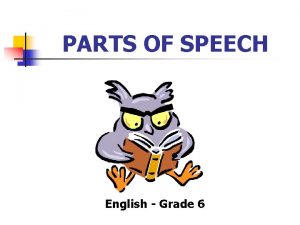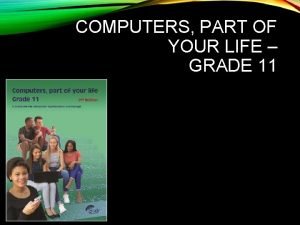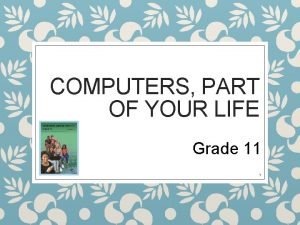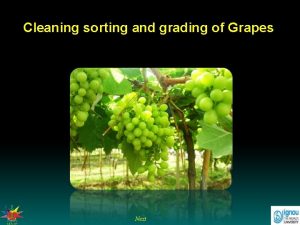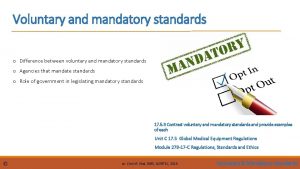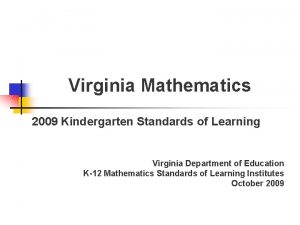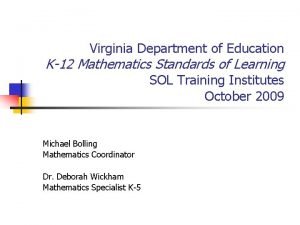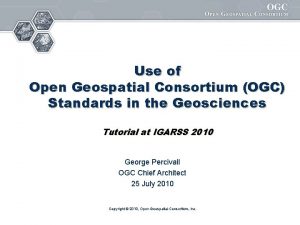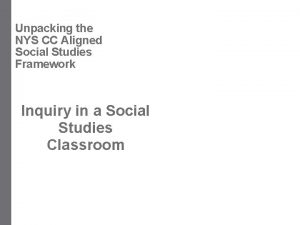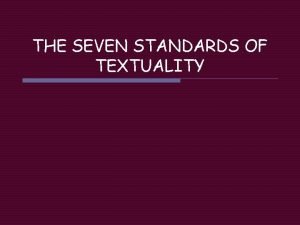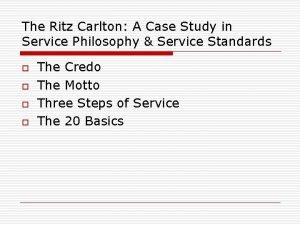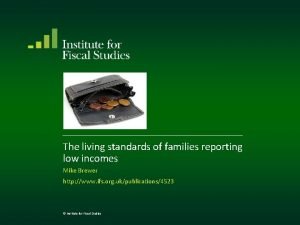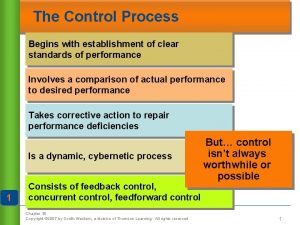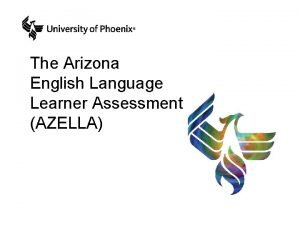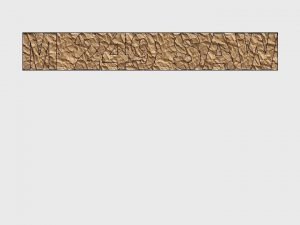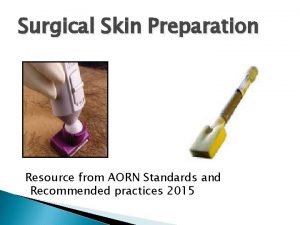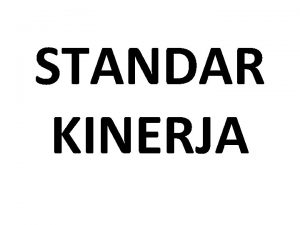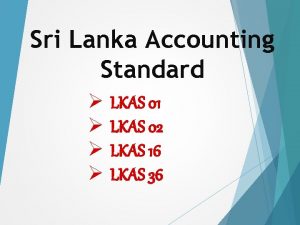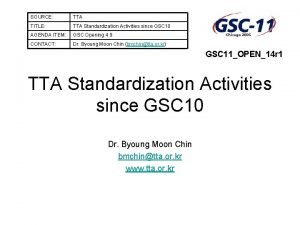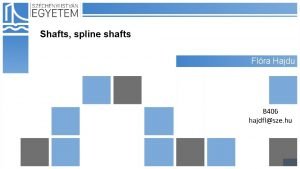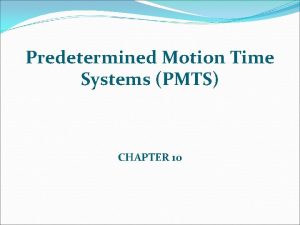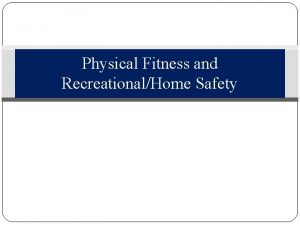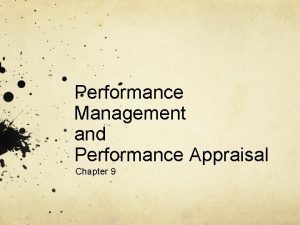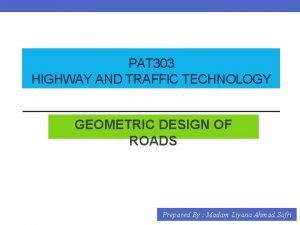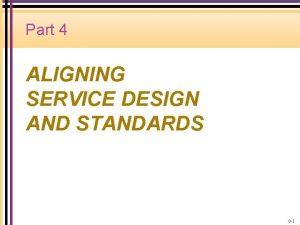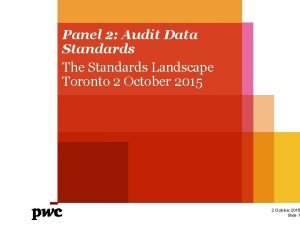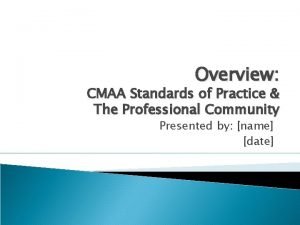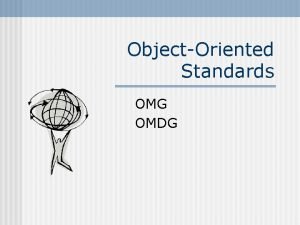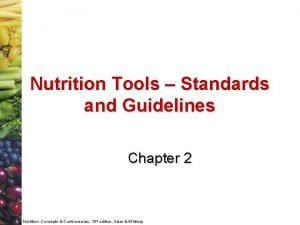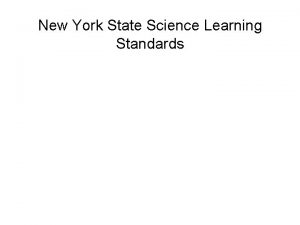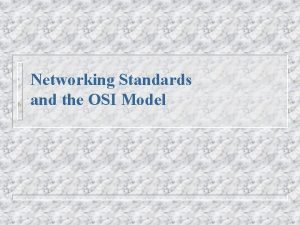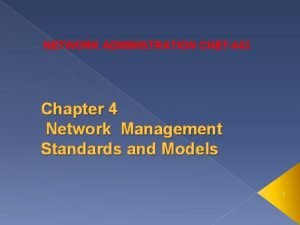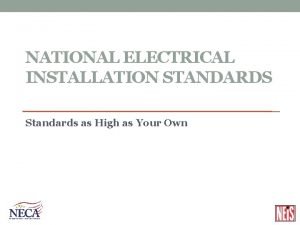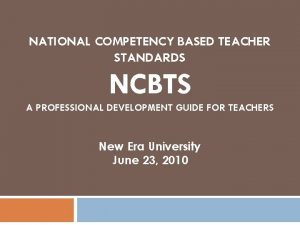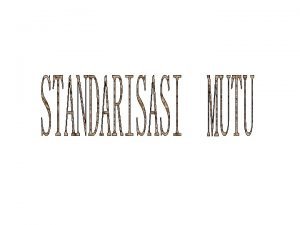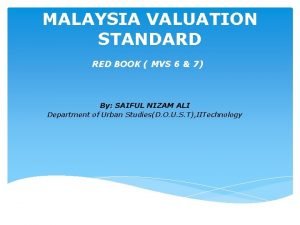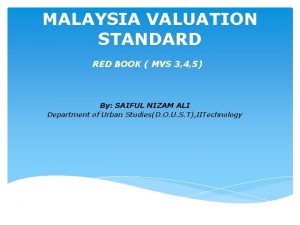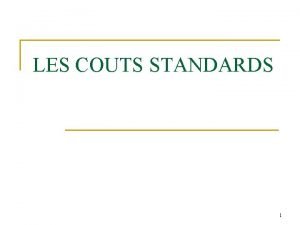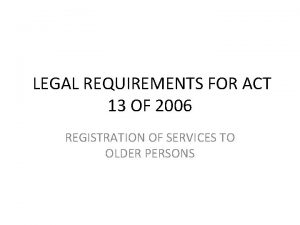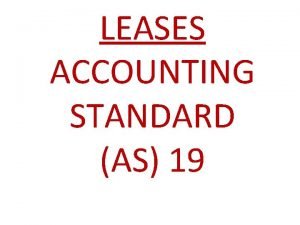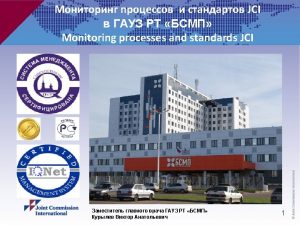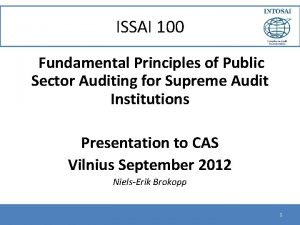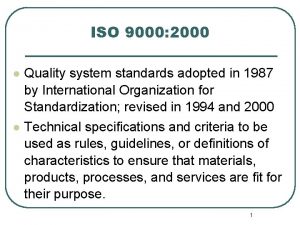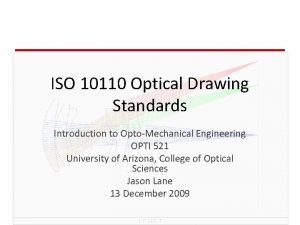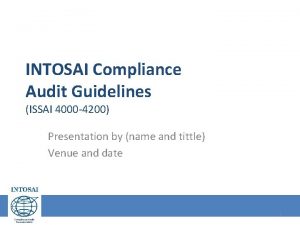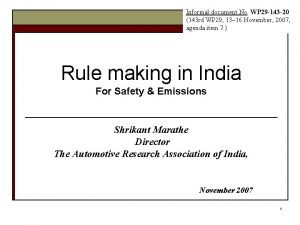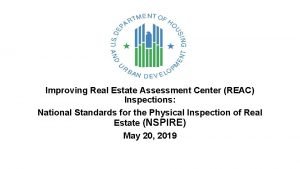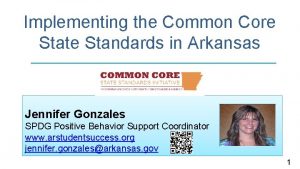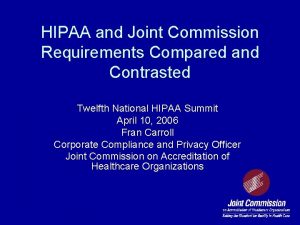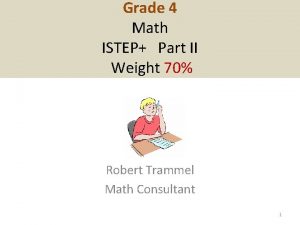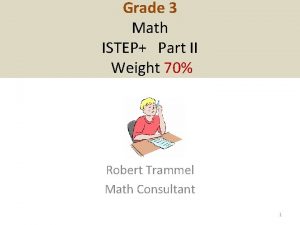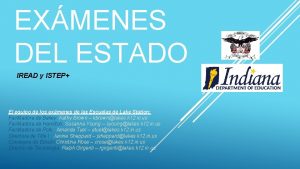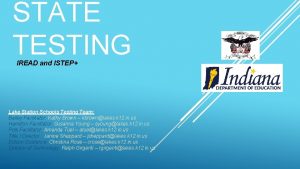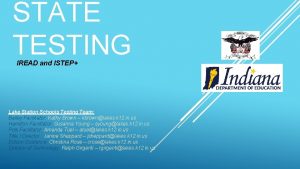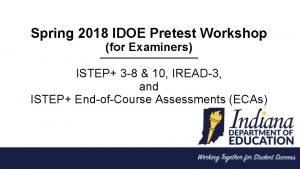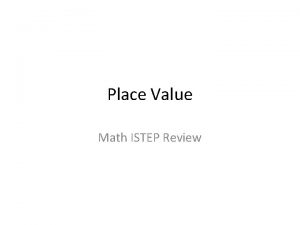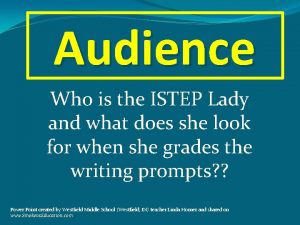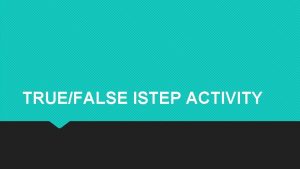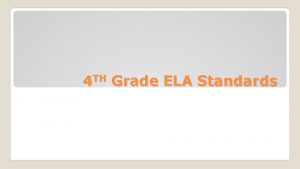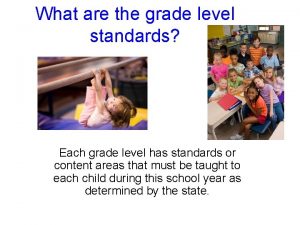ISTEP 10 Part II 8 th Grade Standards

























































































































































- Slides: 153

ISTEP+ 10 Part II 8 th Grade Standards + Algebra 1 Standards Weight = 70% Robert Trammel Math Consultant 1

Message to Teachers The Power. Point Presentation is intended to help students to become familiar with online computer-type questions. There are multiple days of instructional materials that can be easily stretched to 9 or 10 days upon the discretion of the teacher. This Power. Point Presentation can be used as an whole-class instructional tool or in small group settings. The information is based upon standards by rating: � Grade Level Standard Potentially on ISTEP+ Part II only * � Grade Level Standard Potentially on ISTEP+ Parts I&II * � + Very Important Grade Level Standard Potentially on ISTEP+ Parts I&II � + Very Important Grade Level Standard Potentially on ISTEP+ Part II only 2

Question Types on ISTEP+…… Part II ISTEP+ Part II has a variety of question types. The samples that are provided in this document will illustrate the different forms or types of problems that you will see on ISTEP+ Part II. • Multiple Choice……………. select the one correct answer from a choice of 4. • Technology Enhanced……select multiple right answers from a list of 5 -7 choices. • Short Answer…………………answer must be typed on the answer blank provided. • Drag and Drop………………. possible answers are in a menu……. drag and drop answer choices with a mouse to a certain location. 3

Directions: • The problems that follow will be similar to the types of questions on the online version of ISTEP+. • Some problems calculators are permitted. If you see this icon you are allowed to use a calculator. • Some problems require the use of the ISTEP+ reference sheet. If you see this icon you are allowed to ISTEP use the ISTEP reference sheet. Reference • Many of the problems will require some pencil/paper work to find the answer. So…. have a pencil and paper handy. Sheet 4

Day 1 A Number Sense, Expressions, and Computation 11 -21% 5

*� A 1. RNE. 2 Explain why the sum or product of two rational numbers is rational; that the sum of a rational number and an irrational number is irrational; and that the product of a nonzero rational number and an irrational number is irrational. � A 1. RNE. 3 Rewrite and evaluate numeric expressions with positive rational exponents using the properties of exponents. � A 1. RNE. 4 Simplify square roots of non-perfect square integers and algebraic monomials. � A 1. RNE. 5 Simplify algebraic rational expressions, with numerators and denominators containing monomial bases with integer exponents, to equivalent forms. *� A 1. RNE. 6 Factor common terms from polynomials and factor polynomials completely. Factor the difference of two squares, perfect square trinomials, and other quadratic expressions. � A 1. RNE. 7 Understand polynomials are closed under the operations of addition, subtraction, and multiplication with integers; add, subtract, and multiply polynomials and divide polynomials by monomials. 6

� A 1. RNE. 7 Which expression is equivalent to (3 x 5 + 8 x 3) − (7 x 2 − 6 x 3)? Darken the correct letter choice. A − 4 x 3 + 14 B − 4 x 5 + 14 x 3 C 3 x 5 + 14 x 3 − 7 x 2 D 3 x 5 + 2 x 3 − 7 x 2 7

� A 1. RNE. 7 − 3 a(a + b − 5) + 4(− 2 a + 2 b) + b(a + 3 b − 7) Which expression is equivalent to the expression shown? Darken the correct letter choice. A − 11 a 2 + 3 b 2 − 2 ab + 7 a + b B − 11 a 2 + 3 b 2 − 4 ab + 7 a + b C − 3 a 2 + 3 b 2 − 2 ab + 7 a + b D − 3 a 2 + 3 b 2 − 4 ab + 7 a + b 8

� A 1. RNE. 7 Which of the following is equivalent to the expression below? 12(y + 89) Darken the correct letter choice. A 12(89 y) B (12 · 89) + y C (12 · y) + 89 D (12 · y) + (12 · 89) 9

� A 1. RNE. 3 What is the value of the expression shown? 240 ÷ 23 · 10 - 20 Darken the correct letter choice. A 10 B 40 C 280 D 380 10

*� A 1. RNE. 2 The numbers shown in the Menu Box contain rational or irrational numbers. Drag and Drop each number in the Menu Box to either the Rational Number list or the Irrational Number list. Rational Number List Irrational Number List Menu Box π ⅔ π + ⅔ 2. 333 11

� A 1. RNE. 4 Simplify: Darken the correct letter choice. A 10 B 25 C 2 D 5 12

� A 1. RNE. 4 Simplify: Darken the correct letter choice. A 24 xy B 4 xy 2 C 16 xy 2 D 24 xy 2 13

� A 1. RNE. 5 Simplify: A Select all that apply. B C D E F 14

*� A 1. RNE. 6 Factor Completely: 5 x 3 + 30 x 2 + 45 x Darken the correct letter choice. A 5(x 3 + 6 x 2 + 9 x) B 5 x(x 2 + 6 x + 9) C 5 x(x + 3)2 D 5 x(x - 3)2 15

*� A 1. RNE. 6 Factor Completely: x 2 - 81 Darken the correct letter choice. A (x – 9)(x + 9) B x + 9 C x - 9 D 9(x 2 – 9) 16

*� A 1. RNE. 6 Factor Completely: x 2 – 10 x + 25 Darken the correct letter choice. A (x + 5)2 B (x - 5)2 C (x – 2)(x + 5) D (x + 2)(x - 5) 17

*� A 1. RNE. 6 In left column are various expressions. Drag and Drop each expression to the correct completely factored form. Expressions 2 x 2 - 32 Factored Form 2(x + 4)(x – 4) = _________ x 2 + 8 x + 16 8(x 2+ 4) = _________ x 2 + 4 x - 32 (x + 4)(x – 4) = _________ x 2 - 16 (x + 4)2 = _________ (x - 8)(x + 4) = _________ (x + 8)(x - 4) = _________ 2(x 2 - 16) = _________ 18

Day 1 B Number Sense, Expressions, and Computation 11 -21% 19

20

21

� 8. NS. 2 Which graph show the approximate location of ? Choose the correct letter choice. A B C 0 1 3 0 5 1 3 5 0 1 3 5 D 0 1 22

-1 23

24

25

26

27

� 8. NS. 4 Find the solutions for n 2 = 100. Select the correct answer. A Only 50 B 50 and -50 C -10 and 10 D Only 10 E Only -10 28

*� + 8. C. 1 Solve real-world problems with rational numbers by using multiple operations. � 8. C. 2 Solve real-world and other mathematical problems involving numbers expressed in scientific notation, including problems where both decimal and scientific notation are used. Interpret scientific notation that has been generated by technology, such as a scientific calculator, graphing calculator, or excel spreadsheet. 29

*� + 8. C. 1 Joe has a job after school and earns $55 per week. Tasha also has a job after school and earns $65 per week. Joe and Tasha combined their earns for one week and donated 30% of the combined earnings to the local animal shelter. How much money was donated by Joe and Tasha? $36 Answer_______ 30

� 8. C. 2 Object “A” weighs 1. 25 x 1010 milligrams. Object “B” weighs 6. 55 x 1011 milligrams. How much heavier is object B than object A? Darken the correct letter choice. A 5. 3 x 1011 milligrams B 6. 0 x 1010 milligrams C 6. 425 x 1011 milligrams D 7. 425 x 1010 milligrams 31

*� + 8. C. 1 Sherita and Tara play on the Hammond 8 th grade basketball team. The points scored in each game is shown for each player for the first 4 games of the season. Player Game 1 Game 2 Game 3 Game 4 Sherita 10 6 7 7 Tara 9 7 7 11 Which statement describes Sherita’s and Tara’s basketball statistics? Select the correct answer. A Sherita’s average points per game is greater than Tara points per game. B Tara averages 8. 5 points per game and Sherita averages 7. 5 points per game. C Sherita averages 8. 5 points per game and Tara averages 7. 5 points per game. D Together Sherita and Tara average 15 points per game. 32

*� + 8. C. 1 The owner of a computer school is offering a discount on a computer sold in the store. The owner offers COMPUTER SALE! a payment plan where the total cost of the computer is paid in 6 equal Original Price: $598 25% off original price monthly payments. Determine the amount of each monthly 8% tax applied after discount payment. Darken the correct letter choice. A $141. 52 B $74. 75 C $80. 73 D $143. 52 33

� 8. C. 2 Three numbers are shown below: 0. 1234 1. 2 x 10 -2 1. 6 x 102 Which statements are true about the three numbers. Select all that apply. A The sum of all three numbers is 1. 601354 x 102. B The sum of all three numbers is 16. 01354 C The largest number is about 100 more than the smallest number. D The second largest number is 1. 2 x 10 -2. E The largest number is 160. 34

� 8. C. 2 The average distance from Earth to the Moon is approximately ISTEP Reference Sheet 384, 400, 000 meters. What is the average distance, in kilometers, from Earth to the moon written in scientific notation? Darken the correct answer choice. A 3. 844 x 104 kilometers B 3. 844 x 105 kilometers C 3. 844 x 107 kilometers D 3. 844 x 108 kilometers 35

� 8. C. 2 One type of ant weighs about 3 x 10 -3 grams. The ant can carry close to 1. 5 x 10 -1 grams of food on its back. The amount of food, in grams, an ant can carry on its back is approximately how many times its own body weight, in grams? Darken the correct letter choice. A Carries about 50 times its body weight B Carries about 100 times its body weight C Carries about 2 x 10 -1 times its body weight D Carries about 2 x 10 times its body weight 36

Day 2 A Geometry and Measurement 4 -14% 37

ISTEP � 8. GM. 1 Reference Sheet A rectangular solid is shown. What shape is formed by slicing the rectangular solid with a plane parallel to the base? Darken the correct answer. A square B rectangle C triangle D trapezoid 38

ISTEP � 8. GM. 1 Reference Sheet A cylinder is shown. What shape is formed by slicing the cylinder with a plane perpendicular to the base? Darken the correct answer. A Circle B Sphere C Rectangle D Square 39

� 8. GM. 2 ISTEP Reference Sheet A sphere is shown. 40

ISTEP � 8. GM. 2 Reference Sheet A pile of sand is in the shape of a right circular cone. The height of the cone is 10 feet and the radius of the circular bottom is 3 feet. Find the volume of the right circular cone to the nearest cubic foot. Darken the correct answer. A 60 cubic feet 10 B 63 cubic feet C 90 cubic feet 3 D 94 cubic feet 41

� 8. GM. 2 ISTEP Reference Sheet A soccer ball has a radius of 11 cm as shown in the diagram. Find the volume of the soccer ball. Round the answer to the nearest cubic centimeter. Darken the correct answer. Use the π on your calculator. A 138 cubic centimeters B 5, 575 cubic centimeters C 132 cubic centimeters D 5, 572 cubic centimeters 42

� 8. GM. 2 ISTEP Reference Sheet A basketball has a radius of 9 inches. What is the surface area of a 9 -inch radius basketball? Express the answer in terms of π. 324 π Answer_________ square inches 43

8. GM. 4 � Understand that a two-dimensional figure is congruent to another if the second can be obtained from the first by a sequence of rotations, reflections, and translations. Describe a sequence that exhibits the congruence between two given congruent figures. 8. GM. 5 � Understand that a two-dimensional figure is similar to another if the second can be obtained from the first by a sequence of rotations, reflections, translations, and dilations. Describe a sequence that exhibits the similarity between two given similar figures. 8. GM. 6 � Describe the effect of dilations, translations, rotations, and reflections on twodimensional figures using coordinates. 44

ISTEP � 8. GM. 4 Reference Sheet A right triangle CDE is shown on the coordinate plane. After a sequence of two transformations the result is right triangle C'D'E'. Which two transformations were used? Darken the correct letter choice. y D 5 A First a rotation of 90° counterclockwise about the origin followed by a shift down of four units. -5 B First a rotation of 90° clockwise about the origin followed by a shift down of four units. C E C' 5 x D' E' -5 C First a rotation of 180° counterclockwise about the origin followed by a shift up of four units. D First a rotation of 90° clockwise about the origin followed by a shift up of four units. 45

ISTEP � 8. GM. 4 Reference Sheet Two congruent figures 1 and 2 are shown in the coordinate plane. y 5 Which statement describes a possible sequence of transformations that transforms figure 1 into figure 2? Darken the correct letter. 1 -5 5 x 2 -5 A a reflection across the x-axis, followed by a translation 3 units to the left B a reflection across the x-axis, followed by a translation 2 units to the right C a rotation clockwise 180° about the origin, followed by a translation 2 units to the left D a rotation clockwise 180° about the origin, followed by a translation 3 units to the right 46

Day 2 B Geometry and Measurement 4 -14% 47

� 8. GM. 5 In the graph at the right, ABC is dilated by a given factor and then translated to produce RST. How long is RS? Darken the correct letter choice. y A R 5 B C -5 5 A 6 units S T B 7 units x -5 C 8 units D 1 unit 48

� 8. GM. 5 Triangle XYZ, shown on the graph, is reflected across the x-axis then dilated by a scale factor of 3, with the origin as the center of the dilation producing triangle X ' Y ' Z ‘. What are the coordinates of vertices X ' Y ' Z ' ? Darken the correct letter choice. A X' = (4, 24) Y' = (6, 12) Z' = (2, 12) B X' = (12, 24) Y' = (18, 12) Z' = (6, 12) C X' = (− 12, 24) Y' = (− 18, 12) Z' = (− 6, 12) D X' = (– 12, – 24) Y' = (– 18, – 12) Z' = (– 6, – 12) 49

� 8. GM. 6 Triangle ABC is rotated counterclockwise 90° then dilated by a factor of ½. What are the coordinates of the triangle A‘ B‘ C‘ under these two transformations? Darken the correct letter choice. y A A' = (2, 1) B' = (2, 2) C' = (-1, 2) B A' = (1, 2) B' = (2, 2) C' = (2, -1) C A' = (− 2, -1) B' = (− 2, -2) C' = (1, -2) D A' = (-2, -1) B' = (2, -2) C' = (2, 1) 5 C -5 5 -5 A x B 50

� 8. GM. 6 Which two transformations were performed on ABC to produce A‘ B ‘C ‘? Drag and Drop your choices from the menu to correctly complete the statement. Menu y • 90° clockwise rotation about (0, 0) • 90° counterclockwise rotation about (0, 0) B' A' • Reflection across the x-axis. • Reflection across the y-axis. • Translation of 4 units right and one unit up. C' C -5 x 5 • Translation of 4 units left and one unit up. -5 A B The first transformation was_____________________ followed by a second transformation_________________ 51

� 8. GM. 6 Triangle PQR is shown on the coordinate plane. Triangle PQR is rotated 90° counterclockwise about the origin to form the image P‘Q‘R‘ triangle (not shown). Then triangle P‘Q‘R‘ is reflected across the x-axis to form triangle P‘'Q‘'R‘' (not shown). Select the correct letter choice. y What are the signs of the coordinates (x, y) for Q'‘ ? A Both x and y are positive B x is negative and y is positive Q -5 P R C Both x and y are negative D x is positive and y is negative x 5 -5 52

8. GM. 8 � Apply the Pythagorean Theorem to determine unknown side lengths in right triangles in real-world and other mathematical problems in two dimensions. 8. GM. 9 � Apply the Pythagorean Theorem to find the distance between two points in a coordinate plane. 53

ISTEP � 8. GM. 8 Reference Sheet In ABC, BD is perpendicular to AC. The dimensions are shown in centimeters. B What is the length of AC in centimeters? Select the correct choice below. 10 8 A 6 units B 12 units A D 10 C C 7 units D 8 units 54

ISTEP � 8. GM. 8 Reference Sheet The students in a science club planted a rectangular garden in front of their school. The garden is 6 feet wide and the diagonal length is 12 feet as shown. What is the length, L , of the garden in feet? Darken the correct letter choice. Garden A 6 feet B 18 feet 6 feet ee 12 f t L C feet D feet 55

ISTEP � 8. GM. 9 Reference Sheet Find the distance of “c” in the coordinate plane. Select the correct work and the correct answer. Darken the correct letter choice. y A 22 + c 2 = 62 4 + c 2 = 12 c 2 = 8 c = 4 B 22 + 62 = c 2 4 + 36 = c 2 40 = c 2 = c 5 -5 C 2 + 62 = c 2 4 + 36 = c 2 40 = c 2 20 = c D 22 + 82 = c 2 4 + 64 = c 2 = c C 5 x -5 C 56

ISTEP � 8. GM. 8 Reference Sheet Find the missing side length of the right triangle. Darken the correct letter choice. A 10 units ? 12 B 17 units C 14 units 5 D 13 units 57

� 8. GM. 9 ISTEP Reference Sheet The points on the graph show the locations of different places in Alex's school. Each unit represents 1 meter. What is the shortest distance, in meters, between the science lab and the parking lot? Round your answer to the nearest whole meter. 32 Answer_____ meters 58

Day 3 A 9 -19% 59

� + AI. DS. 1: Distinguish between random and non-random sampling methods, identify possible sources of bias in sampling, describe how such bias can be controlled and reduced, evaluate the characteristics of a good survey and well-designed experiment, design simple experiments or investigations to collect data to answer questions of interest, and make inferences from sample results. � * AI. DS. 2: Graph bivariate data on a scatter plot and describe the relationship between the variables. � AI. DS. 3: Use technology to find a linear function that models a relationship for a bivariate data set to make predictions; interpret the slope and y-intercept, and compute (using technology) and interpret the correlation coefficient. � AI. DS. 5: Understand that patterns of association can also be seen in bivariate categorical data by displaying frequencies and relative frequencies in a two-way table. Construct and interpret a two-way table summarizing data on two categorical variables collected from the same subjects. Use relative frequencies calculated for rows or columns (including joint, marginal, and conditional relative frequencies) to describe possible associations and trends in the data. 60

� AI. DS. 5 A survey of high school students found that 73 students own a cell phone and 60 of those students also own an MP 3 player. There were 9 students that do not own a cell phone but own an MP 3 player. Eight students do not own either device. The two-way table is partially completed. Which statements are true about the survey? Select all that apply. A 13 students didn’t have MP 3 players. B 80 students were surveyed in all. MP 3 Player No MP 3 Player Total Cell Phone 60 No Cell Phone 9 Total 8 73 C 90 students were surveyed in all. D 20 students didn’t have either device. E 20 students didn’t have cell phones. 61

� AI. DS. 5 A random sample of 200 teenagers participated in a taste test. Each teenager sampled four choices of fruit drink (labeled A, B, C, and D), and then were asked to pick a favorite. The table shows the results of this taste test. A B C D Total Boys 45 25 30 20 120 Girls 25 10 30 15 80 Total 70 35 60 35 200 Based on the information given, which of the given statements are true? Select all that apply. 62

� + AI. DS. 1 Which random sampling procedure is the best for selecting students in a class to go on a field trip. Darken the collect letter choice. A A teacher wants to select five students from the class. She selects the first five students that enter the room. B A teacher wants to select ten students from the class. She lists students in alphabetical order, then selects every third student. C A teachers wants to select seven students from the class. She selects the best seven students. D A teacher wants to select six students from the class. She writes each student’s name on an index card, places the index cards in a box, mixes the cards, then chooses six cards from the box. 63

� * AI. DS. 2 Linda measured the temperature of a cup of hot chocolate every ten minutes. The scatterplot represents Linda’s recorded data. °F Linda’s Data Which statement below best describes the data? Darken the correct letter choice. 120 110 A The data shows a positive association between time and temperature. Temp (°F) B The data shows a negative association between time and temperature. 100 90 80 C The data is a non-linear trend. 0 D The final temperature of the hot chocolate was 75° F. 10 20 30 40 50 t Time (min) 64

� AI. DS. 3 Linda measured the temperature of a cup of hot chocolate every ten minutes. The scatterplot represents Linda’s recorded data. The line of best fit is shown. °F Which statement below best describes the data? Select all that apply. Linda’s Data 120 110 Temp (°F) 100 90 80 0 10 20 30 40 t 50 Time (min) 65

Day 3 B Data Analysis Statistics Probability 9 -19% 66

8. DSP. 1 *� Construct and interpret scatter plots for bivariate measurement data to investigate patterns of association between two quantitative variables. Describe patterns such as clustering, outliers, positive or negative association, linear association, and nonlinear association. 8. DSP. 2 *� Know that straight lines are widely used to model relationships between two quantitative variables. For scatter plots that suggest a linear association, informally fit a straight line, and describe the model fit by judging the closeness of the data points to the line. 8. DSP. 3 *� Write and use equations that model linear relationships to make predictions, including interpolation and extrapolation, in real-world situations involving bivariate measurement data; interpret the slope and y-intercept. 8. DSP. 5 � Represent sample spaces and find probabilities of compound events (independent and dependent) using methods, such as organized lists, tables, and tree diagrams. 67

*� 8. DSP. 2 Total Calories What kind of a relationship or association between total fat grams and total calories is shown on the scatterplot? Darken the correct letter choice. Fat and Calories for Sandwiches C 0 6000 5000 4000 3000 A Negative linear association 2000 0 B No association 5 10 150 20 250 30 35 g 40 Total Fat Grams C Positive linear association D Zero association 68

c *� 8. DSP. 1 5 4 A scatter plot is shown on the coordinate plane. Which of these most closely approximates a line of best fit for the data in the scatter plot? Darken the correct letter choice. 3 2 1 c 0 A 1 B 3 2 c c 5 5 5 4 4 4 3 3 3 2 2 2 1 1 1 0 1 2 3 4 5 p 4 p 5 C 69 0 1 2 3 4 5 p

Marcus’ Data Hot Chocolate °F *� 8. DSP. 2 120 Marcus put a cup of hot chocolate in a microwave oven for 30 seconds. He took the hot chocolate 110 out of the microwave oven and placed a Temp (°F) thermometer in the cup and recorded the 100 temperature in (°F) every 5 minutes. Marcus’ data is shown below in the scatterplot. 90 Which statements best describe this data collected by Marcus? Select all that apply. 80 75 0 10 20 30 40 t 50 Time (min) A The data shows a positive association between time and temperature. B The data shows a negative association between time and temperature. C The time and temperature association is described as linear D The time and temperature association is described as non-linear. E The hot chocolate reached a final temperature of 50°F. 70

*� 8. DSP. 3 Determine the equation of the line of best fit for the scatterplot shown. Darken the correct letter choice. y 20 18 16 14 12 10 8 6 4 2 0 5 10 15 20 25 71 x

*� 8. DSP. 3 Tom has a bottle of juice. To cool the juice, he places the bottle in a bucket of ice for 10 minutes. The scatter plot shows the temperature, in degrees Fahrenheit (°F), of the juice at the end of each minute. The line of best fit is shown. Which statements about the line of best fit are true? Select all that apply. A The point (0, 72) was when Tom put the juice in the bucket of ice. B The slope of the line of best fit is positive. C The slope of the line of best fit is negative. D The temperature of the juice at 6 minutes was about 40°F. E The juice never was less than 40°F. 72

� 8. DSP. 5 Sam is doing an experiment. He flips a coin and records the result as a head or a tail then he picks a marble from a bag without looking and records the color. The bag contains 1 red marble, 1 blue marble, and 1 white marble. How many outcomes does Sam’s experiment have? Darken the correctly letter choice. A There are 10 outcomes: (Head, Red); (Head, Blue); (Head, White); (Tail, Red); (Tail, Blue) (Tail, White); (Blue, Head); (Red, Tail); (White, Head); (Blue, Tail) B There are 6 outcomes: (Head, Red); (Head, Blue); (Head, White); (Tail, Red); (Tail, Blue); (Tail, White) C There are 3 outcomes: (Head, Red); (Head, Blue); (Head, White) D There are 5 outcomes: (Head, Red); (Head, Blue); (Head, White); (Tail, Red); (Tail, Blue) 73

� 8. DSP. 5 Tonya performed this multi-step experiment. First, she tossed a penny and recorded the outcome as head or tail. Second, she drew a card from a deck of three different cards shown below and recorded the outcome as 3, 6, or 7. First: Penny Toss Second: Drew Card What is the probability that Tonya flips a tail on the coin and draws a 7 of spades? Answer __________ 74

Linear Equations Linear Inequalities Functions 28 -38% 75

Day 4 A Functions 76

A 1. F. 1 � and � 8. AF. 3 Understand that a function from one set (called the domain) to another set (called the range) assigns to each element of the domain exactly one element of the range. Understand that if f is a function and x is an element of its domain, then f(x) denotes the output of f corresponding to the input x. Understand the graph of f is the graph of the equation y = f(x). A 1. F. 2 *� + and � 8. AF. 4 Describe qualitatively the functional relationship between two quantities by analyzing a graph (e. g. , where the function is increasing or decreasing, linear or nonlinear, has a maximum or minimum value). Sketch a graph that exhibits the qualitative features of a function that has been verbally described. Identify independent and dependent variables and make predictions about the relationship. A 1. F. 3 � Identify the domain and range of relations represented in tables, graphs, verbal descriptions, and equations. 77

� A 1. F. 1 and � 8. AF. 3 Select all relations that are functions. A y = 2 x D B y = 2 x + 1 C {(0, 3), (1, 5), (1, 6)} E y x 78

� A 1. F. 1 and � 8. AF. 3 Which of these equations represent functions where x is the input and y is the output? Select all that apply. A x = 2 B x + 7 = 2 C y = 2 x D x = 2 y E x + y = 2 79

� A 1. F. 1 and � 8. AF. 3 The graph represents y as a function of x. y 5 Which additional point can be plotted so that the graph continues to represent y as function of x? Select the correct answer. A (0, 1) -5 5 x -5 B (2, 2) C (3, 4) D (4, 2) 80

� A 1. F. 1 and � 8. AF. 3 Which of these graphs does not represent a function? Darken the correct letter choice. A B C D 81

*� + A 1. F. 2 and � 8. AF. 4 y The graph shows a function for x between -5 and 5. Drag and drop from the menu provided to make each statements true. The maximum for the graph is_____. The minimum for the graph is_____. The graph is decreasing from_____. 5 -5 -5 5 4 -1 5 x -5 -5 5 4 -1 -2. 5 to 5 -1 to 5 0 to 5 82

*� + A 1. F. 2 and � 8. AF. 4 The graph shows a function for x between -5 and 5. Drag and drop from the menu provided to make each statements true. y 5 The maximum for the graph is_____. The minimum for the graph is_____. The graph is increasing from_______. -3 3 2 -2 -5 5 x -5 -5 5 4 -4 -5 to -1 -1 to 5 -5 to 0 and 3 to 5 83

� A 1. F. 1 The cost to manufacture x pairs of sunglasses can be represented by a function, C(x). If it costs $398 to manufacture 4 pairs of sunglasses, which of the following is true? Darken the correct letter choice. A C(4) = 99. 50 B C(398) = 4 C C(4) = 398 D C(99. 50) = 1 84

� A 1. F. 1 Jerome is constructing a table of values that satisfies the definition of a function. Input -13 20 0 -4 11 -1 17 Output -15 -11 -9 -2 -1 5 5 13 Which number(s) can be placed in the empty cell so that the table of values satisfies the definition of a function? Select all that apply. A -5 B -1 C 0 D 2 E 11 85

*� + A 1. F. 2 and � 8. AF. 4 y 5 Which statement best describes y= f(x). Darken the correct letter choice. y = f(x) -5 5 x -5 A Increasing from -5 to 3 and from 3 to 0 and decreasing from 0 to 3. B Increasing from -5 to 0 and from 3 to 5 and decreasing from 0 to 3. C Decreasing -5 to 3 and from 3 to 0 and increasing from 0 to 3. D Decreasing from -5 to 3 and from 3 to 5 and increasing from 0 to 3. 86

� A 1. F. 3 Shown are four different functions of x……. y = f(x) ; y = g(x); y = h(x) and y = k(x) Which two of the four functions have the same domain and the same range? Darken the correct letter choice. y y = f(x) y 5 -5 y = g(x) y 5 5 x -5 -5 y = k(x) y 5 5 5 y = h(x) x -5 5 5 A y = g(x) and y = h(x) B y = f(x) and y = k(x) C y = f(x) and y = g(x) D y = h(x) and y = k(x) 87

� A 1. F. 3 A function is defined by a set of ordered pairs as shown. (-1, 3) ; (-4, 0) ; (-5, 7) ; (-10, -10) Write the domain and the range for the function. -10, -5, -4, -1, 1 Domain: ______________ -10, 0, 3, 7 Range: ______________ 88

Day 4 B Linear Equations and Inequalities In One Variable 89

� A 1. L. 1 and � 8. AF. 1 Understand that the steps taken when solving linear equations create new equations that have the same solution as the original. Solve fluently linear equations and inequalities in one variable with integers, fractions, and decimals as coefficients. Explain and justify each step in solving an equation, starting from the assumption that the original equation has a solution. Justify the choice of a solution method. *� + A 1. L. 2 Represent real-world problems using linear equations and inequalities in one variable and solve such problems. Interpret the solution and determine whether it is reasonable. � A 1. L. 3 Represent real-world and other mathematical problems using an algebraic proportion that leads to a linear equation and solve such problems. 90

� A 1. L. 1 and � 8. AF. 1 Solve this equation for x. 0. 5(5 − 7 x) = 8 − (4 x + 6) Darken the correct letter choice. A 6 B -6 C 1 D -1 91

� A 1. L. 1 and � 8. AF. 1 What values of “x” makes the inequality 5 x + 1 < 3 x – 7 true? Darken the correct answer choice. A x > -4 B x < -4 C x > 4 D x < 4 92

� A 1. L. 1 and � 8. AF. 1 Solve the inequality………… -3 x + 10 > -2 x – 5 for “x. ” Darken the correct answer choice. A x < 5 B x > -5 C x > -15 D x < 15 93

*� + A 1. L. 2 Airline passengers pay $439 to fly to California. For this price, customers may check 2 pieces of luggage. There is a fee of $25 for each additional piece of luggage a passenger wants to check. Which function can be used to find the amount in dollars a passenger has to pay to fly with p pieces of luggage, where p > 2? Darken the correct letter choice. 94

*� + A 1. L. 2 The Summit City Bus Service is going to supply buses to take the sophomore class on a field trip. Each bus has a maximum capacity of 68 people which includes the bus driver, passengers and teachers. Each bus will have two teachers onboard with the students. If there are 330 sophomores going on the field trip, what is the least number of buses needed? Sharon, a math whiz, described and worked the problem as shown. “Each bus will have 65 sophomores on board so I divided 330 by 65 and got 5. 0769 buses. By rounded , like we do in Mr. Wilson’s math class, makes the answer 5 buses. ” Is Sharon’s work and answer correct? Sharon work was correct but her answer was incorrect. Number of buses needed should be 6. 95

*� A 1. L. 3 A store sells ropes in different lengths. This table shows the weights of rope with different lengths. Which equation represents the relationship between the length of the rope, L, in feet, and the weight of the rope, w, in ounces? Darken the correct letter choice. A w = 0. 75 L B w = 1. 2 L Length (feet) Weight (ounces) 12 9 18 13. 5 24 18 30 22. 5 36 27 C w = L – 3 D w = L + 6 96

*� A 1. L. 3 Look at this equation. Solve the equation for x. Darken the correct letter choice. A x = -7 B x = -2 C x = 11 D x = 13 97

Day 4 C 98

� A 1. L. 4 Represent linear functions as graphs from equations (with and without technology), equations from graphs, and equations from tables and other given information (e. g. , from a given point on a line and the slope of the line). *� + A 1. L. 5 Represent real-world problems that can be modeled with a linear function using equations, graphs, and tables; translate fluently among these representations, and interpret the slope and intercepts. *� A 1. L. 6 and � 8. AF. 7 Translate among equivalent forms of equations for linear functions, including slope-intercept, point-slope, and standard. Recognize that different forms reveal more or less information about a given situation. *� A 1. L. 7 Represent real-world problems using linear inequalities in two variables and solve such problems; interpret the solution set and determine whether it is reasonable. Solve other linear inequalities in two variables by graphing. 99

ISTEP � A 1. L. 4 Reference Sheet Line “L” is shown in the coordinate plane. Find the equation of the line. Express the answer in slope-intercept form. Darken the correct answer choice. y 5 L A y = x – 4 B y = 4 x – 4 C y = -4 x + 4 -5 x 5 -5 D y = x + 4 100

ISTEP � A 1. L. 4 Reference Sheet A linear function y = f(x) is shown as a table of values. Find the function in terms of x. Darken the correct letter choice. x -2 f(x) -9 1 -7. 5 3 -6. 5 4 -6 101

ISTEP *� + A 1. L. 5 + Reference Sheet Jerry has a newspaper route he delivers to businesses. He delivers five newspapers to each business. The table of values represents this function where the number of deliveries is “x” and the newspapers left to be delivered is “y. ” Which statements are true about Jerry’s newspaper route? Select all that apply. A The number of newspapers Jerry started with was 220. B The total number of deliveries made by Jerry was 50. C The slope of the line from the table represents 5 newspapers per delivery. x y Number of Deliveries newspapers 0 220 1 215 3 210 4 205 D Jerry has 44 businesses on his paper route. E After the 12 deliveries Jerry has 170 newspapers left. 102

ISTEP *� + A 1. L. 5 + Reference Sheet Libby belongs to a coffee club. She just purchased a steaming hot cup of coffee. Libby checks the temperature of the coffee every 5 minutes with a thermometer. The information was plotted on a grid by Libby connected the points with a line. What does the slope and the y-intercept mean? Select all that apply. 50 Temp(°C) Coffee Club y 40 30 20 10 0 5 10 15 20 t 25 Time 103

ISTEP *� A 1. L. 6 and � 8. AF. 7 Reference Sheet Two utility companies sell electricity in units of kilowatt-hours. The cost of electricity for company P is shown in the table. The cost of electricity for company M can be found by using the equation shown, where y represents the total cost in dollars for x kilowatt-hours of electricity. Electricity Cost Company P Number of Kilowatt-hours Total Cost (dollars) 1, 250 1, 650 $150. 00 $198. 00 Electricity Cost Company M y = 0. 15 x Find the cost, in dollars, of buying 2, 375 kilowatt-hours of electricity from the least expensive company. $285 P Answer $_____ Company______ 104

ISTEP *� A 1. L. 6 and � 8. AF. 7 Reference Sheet The gasoline mileage for two cars can be compared by finding the distance each car traveled and the amount of gasoline used. The table shows the distance that car M traveled using x -gallons of gasoline. The graph shows the distance, y, that car P traveled using x- gallons of gasoline. y Amount of Gasoline (gallons) Distance (miles) 2 50. 4 3 80. 5 7 181. 3 5 137. 5 Distance (miles) Car M Car P 160 120 80 40 0 1 2 3 4 5 x Amount of Gasoline (gallons) Based on the information in the table and the graph, compare the approximate miles per gallon of car M to car P. Which statement is true? A Car M gets less than 30 miles per gallon while Car P gets more than 30 miles per gallon. B Car M gets more than 30 miles per gallon while Car P gets less than 30 miles per gallon. C Car M gets more than 35 miles per gallon while Car P gets more than 30 miles per gallon. D Car M gets less than 25 miles per gallon while Car P gets more than 30 miles per gallon. 105

ISTEP *� A 1. L. 6 and � 8. AF. 7 Reference Sheet Function A and Function B are linear functions. Function A is represented by the table of values. Function B is represented by an equation. Function A Function B X Y 1 2 3 10 4 14 7 26 y = 3 x + 4 Which statements about the properties of Function A and Function B are true? Select each correct statement. A The y-intercept of Function A is equal to the y-intercept of Function B. B The y-intercept of Function A is less than the y-intercept of Function B. C The y-intercept of Function A is greater than the y-intercept of Function B. D The rate of change of Function A is equal to the rate of change of Function B. E The rate of change of Function A is greater than to the rate of change of Function B. 106

ISTEP *� A 1. L. 6 and � 8. AF. 7 Reference Sheet Change 2 x + 3 y = 6 into slope-intercept form. Answer ________________ 107

ISTEP *� A 1. L. 7 Reference Sheet Which graph represents the solution for the inequality y – 3 x ≤ 2? Darken the correct letter choice. A B C D 108

ISTEP *� A 1. L. 7 Reference Sheet Which graph represents the inequality Darken the correct letter choice. A B ? C D 109

Other 8 th Grade Algebra Standards Day 4 D 8. AF. 5 � Interpret the equation y = mx + b as defining a linear function, whose graph is a straight line; give examples of functions that are not linear. Describe similarities and differences between linear and nonlinear functions from tables, graphs, verbal descriptions, and equations. 8. AF. 6 *� Interpret the equation y = mx + b as defining a linear function, whose graph is a straight line; give examples of functions that are not linear. Describe similarities and differences between linear and nonlinear functions from tables, graphs, verbal descriptions, and equations. 8. AF. 2 *� Give examples of linear equations in one variable with one solution, infinitely many solutions, or no solutions. Show which of these possibilities is the case by transforming a given equation into simpler forms, until an equivalent equation of the form x = a, a = a, or a = b results (where a and b are different numbers). 110

ISTEP � 8. AF. 5 Reference Sheet Examine the linear equation…. . y = -2 x + 7. Which statements describe this equation. Select all that apply. A The slope of the graph of the equation is 2. B The y-intercept of the graph of the equation is -2. C The y-intercept of the graph of the equation is 7. D The slope of the graph of the equation is -2. E The point with coordinates (-1, 9) is on the graph of the equation. 111

ISTEP � 8. AF. 5 Reference Sheet Examine the linear equation…. . y = 5 x - 30 Which statements describe this equation. Select all that apply. A The slope of the graph is positive. D The slope of the graph of the equation is 5. E The point with coordinates (-30, 0) is on the graph of the equation. 112

ISTEP *� 8. AF. 6 Reference Sheet • Mark earns $60 for mowing 3 lawns. • Mark earns $300 for mowing 15 lawns. Total Earnings ($) Larry and Mark each mow lawns in their neighborhood. Information about each person’s earnings are shown. Larry’s Earnings y Mark’s Earnings 160 120 80 40 Which statement correctly compares the amount of money Larry and Mark earn per lawn? 0 2 4 6 8 10 12 x Number of lawns Mowed A Larry earns $2 more than Mark earns per lawn. B Larry earns $5 less than Mark earns per lawn. C Larry earns $10 more than Mark earns per lawn. D Larry earns $15 less than Mark earns per lawn. 113

ISTEP *� 8. AF. 6 Reference Sheet Sara uses a cell phone plan that has a flat fee of $60 per month. Voice calls are billed per minute. A 3 -minute phone call costs $0. 75. Write an equation in the form y = mx + b that represents the total cost in y dollars, for x minutes of calls in a month. Darken the correct answer. A y = 3 x +. 75 B y =. 25 x + 60 C y =. 25 x +. 75 D y = 3 x + 60 114

ISTEP *� 8. AF. 6 Reference Sheet Which equation (function) best describes the line graph? Darken the correct letter. A y = 2 x + 1 y 5 -5 5 x B C y = -2 x – 1 D -5 115

ISTEP *� 8. AF. 6 Reference Sheet Bailey has a job delivering newspapers to local stores in Hammond. The newspapers come in “bundles” for easy drop off to stores. The graph below shows the relationship between the number of bundles to the number of newspapers delivered by Bailey. How many newspapers are in each bundle? Select the correct letter choice. A 20 B 50 C 10 D 30 116

*� 8. AF. 2 Which equations have no solution? Select all equations which have no solution. A 5 x – 3 + 2 x = 7 x + 3 B 6 x + 5 = − 2(8 + 6 x) C 3 x + 2(x – 1) = 5 x + 4 D 4 x – 2 + x = – 4 + 3 x + 2 E 9 x + 5 + x = 10 x – 6 + 1 117

*� 8. AF. 2 Select all the equations that have infinite solutions. A 3 x − 6 + 2 x = 5 x + 3 B − 5 x + 9 + 2 x = − 3(x − 3) C 2 x + 1 − 3 x = 6 − x + 5 D 2(x + 4) − 3 = 2 x – 1 E 3 x + 1 + x = -9 + 4 x + 10 118

119

Day 4 E 120

� A 1. L. 8 Solve compound linear inequalities in one variable, and represent and interpret the solution on a number line. Write a compound linear inequality given its number line representation. � - A 1. L. 9 Solve absolute value linear equations in one variable. � - A 1. L. 10 Graph absolute value linear equations in two variables. � A 1. L. 11 Solve equations and formulas for a specified variable, including equations with coefficients represented by variables. 121

� A 1. L. 8 Look at this linear inequality. 7 < 3 m + 4 ≤ 16 Solve the inequality for m. Which shows the correct solution graphed on the number line? Darken the correct answer. A B -10 -5 0 5 10 C D 122

� A 1. L. 8 Which inequality represents the numbers shown on the number line? Darken the correct answer. x -10 -5 0 5 10 A -9 < x > 5 B -9 > x > 5 C -9 < x < 5 D -9 < x < 5 123

� - A 1. L. 9 - Solve each of the three equations of “x. ” Drag and Drop the solution(s) next to each equation. Pick the solution(s) to each equation from the solution menu. Not all of the numbers in the Solution Menu will be used. |x + 1| = 9 Solution: _________ 2|x + 3| = 20 Solution: _________ 2|x - 1| = 8 Solution: _________ Solution Menu 5 -10 8 -5 -13 7 -3 -7 13 -8 124

� - A 1. L. 10 - Which graph correctly shows……. f(x) = |x – 1|? Darken the correct answer. A B C D f(x) 5 -5 5 5 -5 x -5 5 -5 f(x) x -5 5 -5 125 x

ISTEP � A 1. L. 11 Reference Sheet Caroline knows the height (h) and the required volume (V) of a cone-shaped vase she’s designing. Which formula can she use to determine the radius of the vase? Darken the correct letter choice. A r = C B r = D - r h - 126

� A 1. L. 11 3 A B 3 C D 127

Day 5 Systems of Equations Systems Of Inequalities 4 -14% 128

� AI. SEI. 1: Understand the relationship between a solution of a pair of linear equations in two variables and the graphs of the corresponding lines. Solve pairs of linear equations in two variables by graphing; approximate solutions when the coordinates of the solution are non-integer numbers. � AI. SEI. 2: Understand that, given a system of two equations in two variables, replacing one equation by the sum of that equation and a multiple of the other produces a system with the same solutions. Solve pairs of linear equations in two variables using substitution and elimination. *� + AI. SEI. 3: Write a system of two linear equations in two variables that represents a real-world problem and solve the problem with and without technology. Interpret the solution and determine whether the solution is reasonable. � AI. SEI. 4: Represent real-world problems using a system of two linear inequalities in two variables and solve such problems; interpret the solution set and determine whether it is reasonable. Solve other pairs of linear inequalities by graphing with and without technology. *� 8. AF. 8: Understand that solutions to a system of two linear equations correspond to points of intersection of their graphs because points of intersection satisfy both equations simultaneously. Approximate the solution of a system of equations by graphing and interpreting the reasonableness of the approximation. 129

ISTEP *� 8. AF. 8 Reference Sheet Consider the system of equations. y = 2 x + 2 y = 6 x + 2 Which statements are true about the system of equations? Select all that apply. A The graph of the system consists of lines that have no points of intersection. B The graph of the system consists of lines that have exactly one point of intersection. C The graph of the system consists of lines that have more than one point of intersection. D The system has no solution. E The system has exactly one solution. F The system has more than one solution. 130

ISTEP *� 8. AF. 8 Reference Sheet Consider the system of equations. y = 2 x - 1 y = 2 x + 3 Which statements are true about the system of equations? Select all that apply. A The graph of the system consists of lines that have no points of intersection. B The graph of the system consists of lines that have exactly one point of intersection. C The graph of the system consists of lines that have more than one point of intersection. D The system has no solution. E The system has exactly one solution. F The system has more than one solution. 131

ISTEP *� 8. AF. 8 Reference Sheet Two lines are graphed on the same coordinate plane. The lines only intersect at the point (3, 6). Which of these systems of linear equations could represent the two lines? Select all that apply. A x = 3 y = 6 B x = 6 + y C y = 3 x - 3 y = 3 + x y = x - 1 D x = 3 + y y = 6 + x E y = x + 3 y = 2 x 132

ISTEP � A 1. SEI. 1 Reference Sheet Two lines are graphed on the same coordinate plane that represent a system of equations. Approximate the solution. y 5 1 -1½ Answer ( , ) -5 5 x -5 133

ISTEP � A 1. SEI. 2 Reference Sheet Solve this system of linear equations. 2 x – 3 y = – 10 3 x + 9 y = – 15 What is the value of x in the solution to the system? A x = 5 B x = 0 C x = -5 D x = -9 134

ISTEP � A 1. SEI. 2 Reference Sheet Solve this system of linear equations. 3 x – 6 y = 30 y = -6 x + 34 What is the solution to the system? ( , ) 6 -2 135

ISTEP *� + A 1. SEI. 3 + Reference Sheet Hammond High School is planning an after school trip involving 193 people. There are eight drivers available and two types of vehicles, school buses and minivans. The school buses seat 51 people each, and the minivans seat 8 people each. How many buses and minivans will be needed? Do each part of this problem (A, B, and C) in order. Part A Define the variables for the problem. Let b = the number of buses needed Let m = the number of minivans needed Part B Write the two equations. b + m = 8 51 b + 8 m = 193 Part C Need 3 buses and 5 minivans Solve the two equations. Solution ____________ 136

ISTEP *� + A 1. SEI. 3 + Reference Sheet Gavit High School’s play sold 456 tickets. An adult ticket cost $3. 50 each. A student ticket cost $1 each. The total ticket sales equaled $1131. How many adult tickets were sold and how many student tickets were sold for the school play? Do each part of this problem (A, B, and C) in order. Part A Define the variables for the problem. Let a = the number of adult tickets sold Let s = the number of student tickets sold Part B Write the two equations. a + s = 456 3. 50 a + 1 s = 1131 Part C 270 adult tickets sold and 186 student tickets sold Solve the two equations. Solution _____________________ 137

ISTEP � A 1. SEI. 4 Reference Sheet Look at this system of inequalities graphed on the coordinate plane. – 2 x + y ≥ – 4 –x + 2 y < 4 Which point is a solution to the system? Darken the correct letter choice. A (0, 2) B (2, 1) C (4, 4) D (4, 1) 138

ISTEP � A 1. SEI. 4 Reference Sheet Look at this system of inequalities graphed on the coordinate plane. Which point is a solution to the system? Darken the correct letter choice. A (0, 3) B (2, 1) C (4, 4) D (4, 1) 139

Day 6 5 -15% 140

� AI. QE. 1: Distinguish between situations that can be modeled with linear functions and with exponential functions. Understand that linear functions grow by equal differences over equal intervals, and that exponential functions grow by equal factors over equal intervals. Compare linear functions and exponential functions that model real-world situations using tables, graphs, and equations. *� AI. QE. 3: Graph exponential and quadratic equations in two variables with and without technology. � AI. QE. 4: Solve quadratic equations in one variable by inspection (e. g. , for x 2 = 49), finding square roots, using the quadratic formula, and factoring, as appropriate to the initial form of the equation. *� AI. QE. 5: Represent real-world problems using quadratic equations in one or two variables and solve such problems with and without technology. Interpret the solution and determine whether it is reasonable. � AI. QE. 6: Use the process of factoring to determine zeros, lines of symmetry, and extreme values in real-world and other mathematical problems involving quadratic functions; interpret the results in the real-world contexts. *� AI. QE. 7: Describe the relationships among the solutions of a quadratic equation, the zeros of the function, the x-intercepts of the graph, and the factors of the expression. 141

ISTEP � A 1. QE. 1 Reference Sheet Which graph correctly shows an exponential function? Darken the correct letter choice. A B C D f(x) 5 -5 5 5 -5 x -5 5 -5 f(x) x -5 5 -5 142

ISTEP � A 1. QE. 1 Reference Sheet At the beginning of an experiment, the number of bacteria, b(t), in a colony was counted to be 4 when t = 0. The number of bacteria in the colony minutes after the initial count is modeled by the function b(t) = 4(2)t. Which value represents the average rate of change in the number of bacteria for the first 5 minutes of the experiment? Darken the correct letter choice. 143

ISTEP � A 1. QE. 4 Reference Sheet Solve each of the three equations of “x. ” Drag and Drop the solution(s) next to each equation. Pick the solution(s) to each equation from the solutions menu. Not all of the numbers in the Solution Menu will be used. Solutions Menu x 2 + 1 = 17 Solution: _________ 8 -4 -8 x 2 -5 x - 24 = 0 Solution: _________ 2 x 2 + 4 x - 5 = 0 Solution: _________ 4 3 -3 9 144

ISTEP � A 1. QE. 4 Reference Sheet Solve the equation……. x 2 + x = 4 Darken the correct letter choice. A x = B x = C x = D x = 145

ISTEP *� A 1. QE. 7 Reference Sheet Which factorization can be used to find the zeros of the function f(n) = -12 n 2 - 11 n + 15 ? Darken the correct letter choice. A B C D f(n) = -n(12 n + 11) + 15 f(n) = (-4 n + 3)(3 n + 5) f(n) = -(4 n + 3)(3 n + 5) f(n) = (4 n + 3)(-3 n + 5) 146

ISTEP *� A 1. QE. 7 Which of the plotted points on the graph represent the zeros of the function? Reference Sheet Several points are plotted on the graph. f (x) = (x 2 + 2 x - 8)(x - 6)? 8 Select all that apply. A (2, 0) B (6, 0) C (0, -8) D (-4, 0) G 6 4 2 E -8 -6 F D -4 A 0 -2 B 2 4 6 8 -2 -4 -6 E (-6, 0) -8 C F (0, 2) G (0, 8) 147

ISTEP � A 1. QE. 6 Reference Sheet The figure shows a graph of the function of f(x) in the xy-coordinate plane. Drag and drop from the selection menu to make each statement true. Not all responses in the selection menu will be used. y (-2, 0) Selection Menu (9, 1) (2, 0) down (0, 8) (8, 0) (4, 0) (0, 4) (0, -2) (-1, 7) (1, 9) greater than equals up --------------------------------- The vertex of the parabola is ______. y = f(x) x The x-intercepts of the parabola are ______. The parabola opens ______. f(0) is ______f(3) 148

ISTEP � A 1. QE. 6 Reference Sheet A tennis ball was 2 feet off the ground when a tennis player hit it so that the ball traveled up in the air before coming back to the ground. The height of the tennis ball is described by the graph shown. Numbers along the x-axis represent the time, in seconds, after the ball was hit, and the numbers along the y-axis represent the height, in feet, of the ball at time x. y Which statement best describes this situation? Select all that apply. 6 A The tennis ball’s maximum height was 6 feet. B The tennis ball was in the air for 1 second. C The tennis ball started at ground level, D The tennis ball was in the air about 1. 1 seconds. E The vertex of the parabolic path is located at (0. 5, 6). Height(feet) 5 4 3 2 1 0 0. 5 1 1. 5 Time(seconds) 149

ISTEP *� A 1. QE. 3 Reference Sheet f(x) A (0, 4) ; (4, 0) ; (2, 3) B (3, 2. 5) ; (-3, 0) ; (5, 0) C (0, 4) ; (4, 0) ; (2, 4) D (-1, 2. 5) ; (3, 2. 5) ; (4, 0) P x R Q E (-1, 2. 5) ; (3, 2. 5) ; (4, 1) 150

ISTEP *� A 1. QE. 5 Reference Sheet The height of a baseball, h(t), measured in feet after being hit, t, measured in seconds, is given by the function h(t) = -16 t 2 + 80 t + 3. Find the time “t” it takes the baseball to hit the ground. Round answer(s) to the nearest thousandths of a second. Darken the correct answer. A t ≈ -. 037 seconds and t ≈ 5. 037 seconds B t ≈ -. 037 seconds only C t ≈ 5. 037 seconds only D t ≈ 2. 537 seconds 151

ISTEP *� A 1. QE. 3 Reference Sheet Three ordered pairs are shown to be on the graph of y = 2 x. These are P(-1, 0. 5) ; Q(0, 1) and R(3, 8). Which are other points on the graph of y = 2 x? Select all that apply. R y A (2, 4) and (4, 16) B (2, 8) and (4, 16) C (2, 4) and (0, 2) D (-2, . 25) and (0, 2) P Q x E (-2, . 25) and (2, 4) 152

ISTEP *� A 1. QE. 5 Reference Sheet The height of a baseball, h(t), measured in feet after being hit, t, measured in seconds, is given by the function h(t) = -16 t 2 + 80 t + 3. Find the time “t” it takes the baseball reach its maximum height. Darken to correct answer. A t ≈ 2. 5 seconds B t ≈ 1 second C t ≈ 5 seconds D t ≈ 4. 5 seconds 153
 Grafic
Grafic Istep 5 inch
Istep 5 inch Hard customer defined standards
Hard customer defined standards Osha 1926 cfr subpart c definition
Osha 1926 cfr subpart c definition 5th grade writing standards georgia
5th grade writing standards georgia Indiana state standards math
Indiana state standards math Georgia standards of excellence ela
Georgia standards of excellence ela Next generation learning standards nys
Next generation learning standards nys Oklahoma state department of education math standards
Oklahoma state department of education math standards Elagse
Elagse Part whole model subtraction
Part whole model subtraction Unit ratio definition
Unit ratio definition Part part whole
Part part whole Part by part technical description example
Part by part technical description example Bar components
Bar components The phase of the moon you see depends on ______.
The phase of the moon you see depends on ______. Two way anova minitab 17
Two way anova minitab 17 Grade 6 parts of speech
Grade 6 parts of speech Computer part of your life grade 11
Computer part of your life grade 11 Computers, part of your life grade 11 answers pdf
Computers, part of your life grade 11 answers pdf Initial grade and transmuted grade
Initial grade and transmuted grade Doctor, lawyer, indian chief jump rope
Doctor, lawyer, indian chief jump rope What is the white part of an egg called
What is the white part of an egg called Grade a milk vs grade b
Grade a milk vs grade b Grading of grapes
Grading of grapes Meta - change morph
Meta - change morph Ihs workbench
Ihs workbench Warehouse storage capacity calculation
Warehouse storage capacity calculation Mandatory standards
Mandatory standards 2009 mathematics standards of learning answers
2009 mathematics standards of learning answers Vdoe math standards
Vdoe math standards Va handbook 5017 part iii appendix a
Va handbook 5017 part iii appendix a Open geospatial consortium standards
Open geospatial consortium standards Social studies standards nys
Social studies standards nys Posix
Posix Mizzou identity standards
Mizzou identity standards Iso 9000 standards
Iso 9000 standards Asprs accuracy standards
Asprs accuracy standards Understanding standards sqa
Understanding standards sqa National 5 pe portfolio marking instructions
National 5 pe portfolio marking instructions Understanding standards media
Understanding standards media Ah geography understanding standards
Ah geography understanding standards National 5 understanding standards
National 5 understanding standards Sqa art and design understanding standards
Sqa art and design understanding standards Sqa understanding standards art and design
Sqa understanding standards art and design Advanced higher computing
Advanced higher computing Sqa higher english understanding standards
Sqa higher english understanding standards Pa common core standards
Pa common core standards Alsde transition standards
Alsde transition standards Training contract record example
Training contract record example Sra training record template
Sra training record template Moral standards examples
Moral standards examples World language standards indiana
World language standards indiana Beaugrande and dressler seven standards of textuality
Beaugrande and dressler seven standards of textuality Credo the ritz carlton
Credo the ritz carlton What are material living standards
What are material living standards Jcaho standards
Jcaho standards The control process begins when
The control process begins when Arizona elp standards
Arizona elp standards Tni 2016
Tni 2016 2012 texas accessibility standards
2012 texas accessibility standards Task conditions standards army
Task conditions standards army Cloroprep
Cloroprep Auditing standards differ from auditing procedures
Auditing standards differ from auditing procedures Etsi - ict standards
Etsi - ict standards Performance history
Performance history As1428 stair nosing
As1428 stair nosing Lkas 2 definition
Lkas 2 definition Osha telecommunications standards
Osha telecommunications standards Tta standards
Tta standards Software quality assurance iso standards
Software quality assurance iso standards Shaft undercut standards
Shaft undercut standards Sas standards aligned system
Sas standards aligned system Revised section 508 standards
Revised section 508 standards Quality control standards
Quality control standards How did the valet prepare guest clothes?
How did the valet prepare guest clothes? Pmp gold plating
Pmp gold plating Marriott brand standard audit
Marriott brand standard audit Evaluation standards
Evaluation standards Saudi standards, metrology and quality organization
Saudi standards, metrology and quality organization The standards of prehospital emergency care
The standards of prehospital emergency care Predetermined motion time standards
Predetermined motion time standards Wmels 5 domains
Wmels 5 domains Navy prt standards
Navy prt standards Domain 4 curriculum
Domain 4 curriculum Cdash domains
Cdash domains Graphic rating scale
Graphic rating scale Ieee software engineering standards
Ieee software engineering standards Road design standards
Road design standards Aligning service design and standards
Aligning service design and standards Audit data standards
Audit data standards Owasp coding standards
Owasp coding standards Office of health standards compliance
Office of health standards compliance Issai standards
Issai standards Kenya professional teaching standards (kepts)
Kenya professional teaching standards (kepts) Interoperability standards advisory
Interoperability standards advisory Construction management standards of practice
Construction management standards of practice Open standards for the practice of conservation
Open standards for the practice of conservation Capte standards and elements
Capte standards and elements Object management group
Object management group Nwccu accreditation standards
Nwccu accreditation standards Nutrition tools standards and guidelines
Nutrition tools standards and guidelines Hsc minimum standards practice test
Hsc minimum standards practice test Nln cnea accreditation
Nln cnea accreditation New york state standards science
New york state standards science Nj groundwater quality standards
Nj groundwater quality standards Nevada state science standards
Nevada state science standards Networking standards organizations
Networking standards organizations Network management standards
Network management standards Nelp standards
Nelp standards Clas standards 5-8
Clas standards 5-8 Ansi/neca 1-2015
Ansi/neca 1-2015 What are the national core standards
What are the national core standards National competency based teacher standards
National competency based teacher standards Interdisciplinary vs multidisciplinary
Interdisciplinary vs multidisciplinary Michigan grade level content expectations
Michigan grade level content expectations Why are standards needed?
Why are standards needed? Michigan mcoles test
Michigan mcoles test Mtts standards
Mtts standards General marketing standards
General marketing standards What are quality standards in project management
What are quality standards in project management Mvs valuation
Mvs valuation Redbook malaysia
Redbook malaysia Health standards louisiana
Health standards louisiana Logo who
Logo who Local accounting standards
Local accounting standards Cout standard def
Cout standard def Dq98 form
Dq98 form As 19 leases
As 19 leases Kansas ela standards
Kansas ela standards Missouri juvenile officer performance standards
Missouri juvenile officer performance standards Jci
Jci Jcaho nursing
Jcaho nursing Issai100
Issai100 Iso 9000 standards
Iso 9000 standards Iso 9001 drawing standards
Iso 9001 drawing standards Isa 95 standards
Isa 95 standards Quality preschool program standards
Quality preschool program standards Iuss standards
Iuss standards Australian standards for texture modified foods and fluids
Australian standards for texture modified foods and fluids Metro ethernet forum standards
Metro ethernet forum standards Issai standards
Issai standards International property measurement standards
International property measurement standards International construction measurement standards
International construction measurement standards International association for information and data quality
International association for information and data quality Automotive regulations and standards
Automotive regulations and standards Nspire hud
Nspire hud Common core state standards arkansas
Common core state standards arkansas Danielson framework summary
Danielson framework summary Bryan zaharko
Bryan zaharko International color consortium
International color consortium Hse stress management standards
Hse stress management standards Hse management standards
Hse management standards Joint commission accreditation standards
Joint commission accreditation standards
